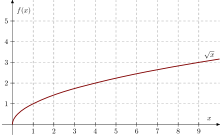nth root


An n-th root of a number r is a number which, if n copies are multiplied together, makes r. It is also called a radical or a radical expression. It is a number k for which the following equation is true:
(for the meaning of , see Exponentiation.)
We write the nth root of r as .[1] If n is 2, then the radical expression is a square root. If it is 3, it is a cube root.[2][3] Other values of n are referred to using ordinal numbers, such as fourth root and tenth root.
For example, because . The 8 in that example is called the radicand, the 3 is called the index, and the check-shaped part is called the radical symbol or radical sign.
Roots and powers can be changed as shown in .
The product property of a radical expression is the statement that . The quotient property of a radical expression is the statement .[3], b != 0.
Simplifying
[change | change source]This is an example of how to simplify a radical.
If two radicals are the same, they can be combined. This is when both of the indexes and radicands are the same.[4]
This is how to find the perfect square and rationalize the denominator.
Related pages
[change | change source]References
[change | change source]- ↑ "List of Arithmetic and Common Math Symbols". Math Vault. 2020-03-17. Retrieved 2020-09-22.
- ↑ Weisstein, Eric W. "nth Root". mathworld.wolfram.com. Retrieved 2020-09-22.
- ↑ 3.0 3.1 "nth Roots". www.mathsisfun.com. Retrieved 2020-09-22.
- ↑ "Add and Subtract Radicals". mathbitsnotebook.com. Retrieved March 14, 2018.


![{\displaystyle y={\sqrt[{3}]{x}}}](https://wikimedia.org/api/rest_v1/media/math/render/svg/be50c0a49b200fb46800951d0268b0a9d4e3fdda)


![{\displaystyle {\sqrt[{n}]{r}}}](https://wikimedia.org/api/rest_v1/media/math/render/svg/10eb7386bd8efe4c5b5beafe05848fbd923e1413)
![{\displaystyle {\sqrt[{3}]{8}}=2}](https://wikimedia.org/api/rest_v1/media/math/render/svg/1f378331b0d609846c021c1a0bbff0a4fc1755c3)

![{\displaystyle {\sqrt[{b}]{x^{a}}}=x^{\frac {a}{b}}=({\sqrt[{b}]{x}})^{a}=(x^{a})^{\frac {1}{b}}}](https://wikimedia.org/api/rest_v1/media/math/render/svg/4544e75b651438a19b60a771c8331028d382556c)




![{\displaystyle 2{\sqrt[{3}]{7}}-6{\sqrt[{3}]{7}}=-4{\sqrt[{3}]{7}}}](https://wikimedia.org/api/rest_v1/media/math/render/svg/3ff82c690c751d252b91bad3a2dd4f564df33eb9)
